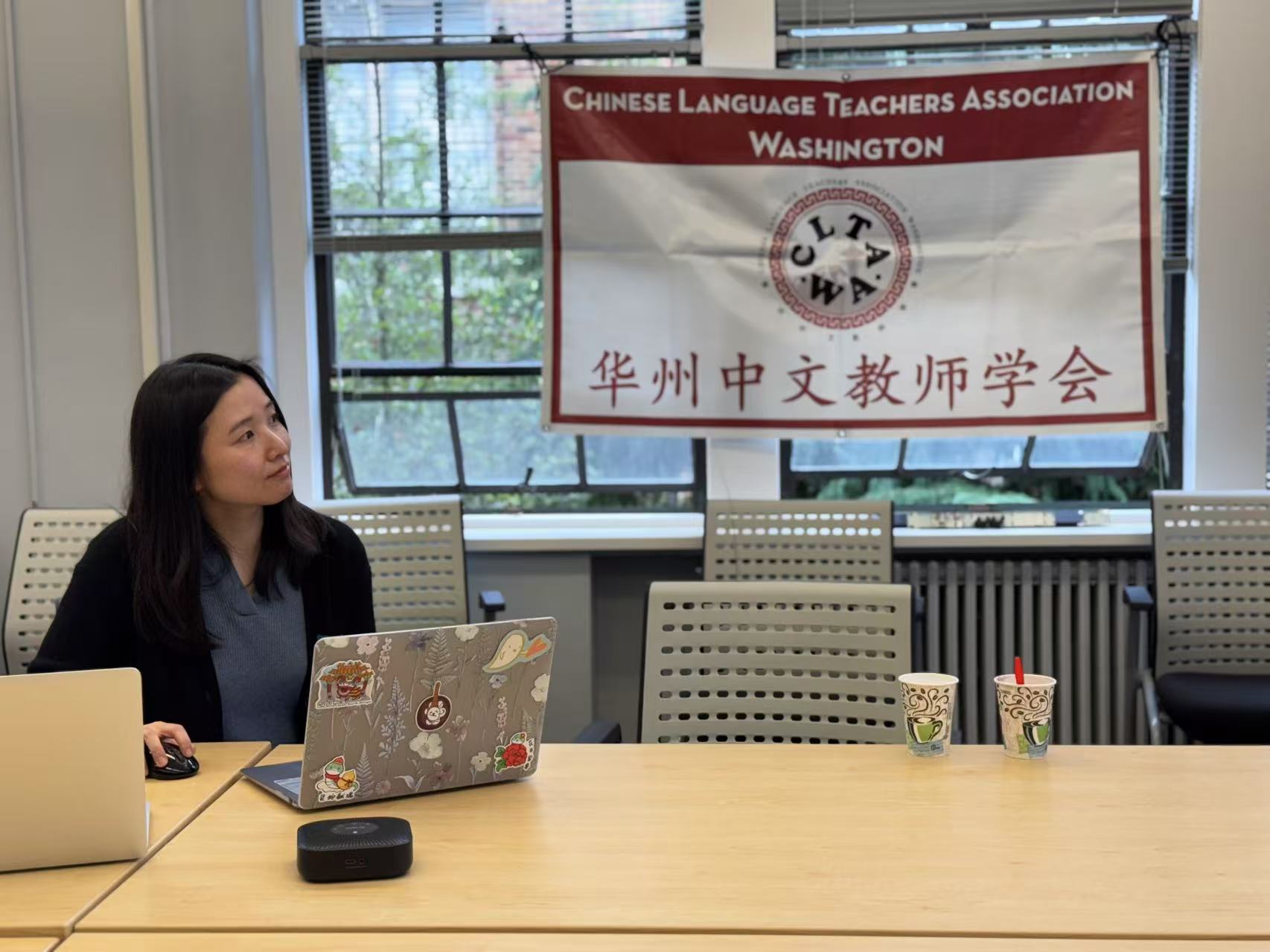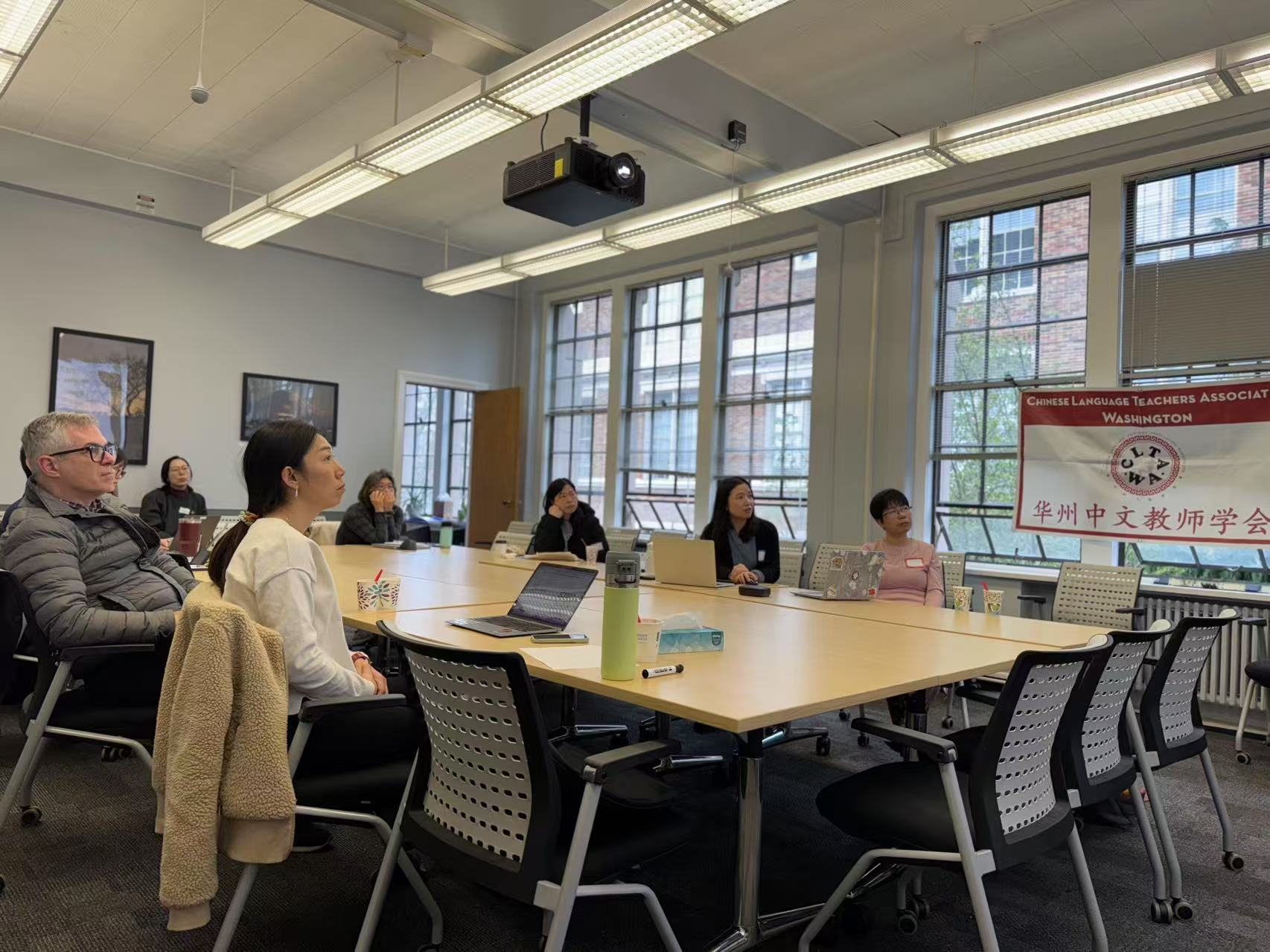On March 2, 2025, the Chinese Language Teachers Association of Washington (CLTA-WA), in collaboration with the Washington State Confucius Institute, hosted a workshop titled “Teaching Beginning-Level Chinese Characters and Vocabulary in the Digital Age” at the University of Washington. Led by Dr. Xi Ma, Assistant Teaching Professor at UW and CLTA-WA’s 2024-2025 Advisor, the event brought together Chinese language educators to explore innovative teaching methods for the digital era. Over 80 teachers joined online, with around 10 attending in person, including President Liu of the Washington Confucius Institute. The workshop created a dynamic and collaborative atmosphere, equipping educators with practical tools and strategies to enhance their teaching in today’s digital landscape.
Workshop Overview
The workshop focused on the challenges and opportunities of teaching Chinese characters to beginning-level learners, particularly in the context of the growing reliance on digital tools. Dr. Ma shared her expertise on integrating e-writing (typing) into the curriculum while balancing traditional handwriting practices. The session provided a comprehensive exploration of theoretical foundations, practical strategies, and digital resources for effective Chinese character instruction.
Key Highlights
- Theoretical Foundations
Dr. Ma began by discussing the cognitive processes involved in learning Chinese characters, emphasizing the importance of phonetic awareness, orthographic knowledge, and character component recognition. She highlighted how digital tools can support these processes, especially for learners from alphabetic language backgrounds.
- E-Writing vs. Handwriting
A significant portion of the workshop was dedicated to the debate between e-writing and handwriting. Dr. Ma presented research showing that while handwriting aids in developing orthographic knowledge and character recognition, e-writing enhances phonetic awareness and typing efficiency. She advocated for a balanced approach, prioritizing e-writing in the digital age while selectively incorporating handwriting to reinforce character structure and meaning.
- Practical Teaching Strategies
Participants were introduced to a variety of teaching activities designed to engage students in both e-writing and handwriting. These included:
– Phonetic Radicals: Using phonetic components to help students recognize and remember characters.
– Character Analysis: Breaking down characters into their components to improve understanding and retention.
– Contextual Learning: Incorporating characters into meaningful contexts, such as storytelling, role-playing, and digital communication tasks.
- Digital Tools and Resources
Dr. Ma showcased several digital tools to enhance character learning, including:
– Typing Tutors: Platforms like 金山打字通 for practicing character typing.
– Interactive Videos: Tools like Powtoon for creating engaging character-learning videos.
– Text-to-Speech Tools: Platforms like ElevenLabs and TTSMaker to help students connect pronunciation with character recognition.
- Hands-On Activities
Participants engaged in a collaborative activity where they designed a lesson plan incorporating both e-writing and handwriting components. The activity focused on teaching spatial vocabulary (e.g., 前面, 后面, 旁边) and included a mix of digital and traditional exercises. The results were shared on Curipod, where participants voted on the most effective designs.
- Key Takeaways from the Q&A Session
The workshop concluded with an engaging Q&A session, during which participants addressed specific challenges and sought further clarification from Dr. Ma. Key topics included:
– Strategies for teaching challenging Mandarin initials (e.g., q, x, z, zh, ch, sh, r) using visual aids and digital tools.
– Accessibility of character practice websites, with many free resources like 金山打字通 available.
– Classroom management tips for large classes, such as incorporating digital tools and group-based e-writing activities.
– A phased approach to balancing e-writing and handwriting, transitioning to more e-writing as students advance.
– Recommendations for digital platforms like Canvas for assessments.
Dr. Ma also emphasized that her teaching examples, while aimed at college-level beginners, could be adapted for younger learners. She highlighted the importance of tailoring storytelling methods like TPRS (Teaching Proficiency through Reading and Storytelling) to incorporate American pop culture for high school students.
The session also featured resource sharing, including tools like Powtoon for creating engaging content, radical practice websites, and podcasts. Dr. Ma’s thoughtful responses and practical solutions left participants feeling inspired and equipped to implement these strategies in their classrooms. The Q&A not only addressed immediate concerns but also sparked ideas for future workshops, particularly on designing activities for high school students and integrating cultural elements into language teaching.
Impact on Teaching Practice
The workshop provided educators with a deeper understanding of how to integrate digital tools into their teaching while maintaining the benefits of traditional handwriting. Participants left with practical strategies and resources that can be directly applied to their classrooms, helping students build a strong foundation in Chinese character recognition, typing, and overall language proficiency.
Participant Feedback
Participants praised the workshop for its practical focus and the wealth of resources shared. Many appreciated the balanced approach to e-writing and handwriting, noting that it addressed the realities of modern language learning while preserving the cultural and cognitive benefits of traditional methods.
Looking Ahead
The success of the March workshop has set the stage for future CLTA-WA events, as educators continue to seek innovative ways to teach Chinese in the digital age. The insights gained from this workshop will undoubtedly inspire new teaching practices and contribute to the ongoing professional growth of Chinese language educators.
Member-Only Resources
For those who missed the workshop or wish to revisit the materials, the slides, recordings, and additional resources are available on the CLTA-WA member-only page: https://www.clta-wa.org/workshop-resources-members-only/ . Access the page using the password shared with members.
As we reflect on the success of this workshop, we look forward to continuing our mission of supporting Chinese language educators in their professional development and enhancing the learning experiences of their students. Thank you to Dr. Xi Ma and all the participants for making this event a resounding success!






